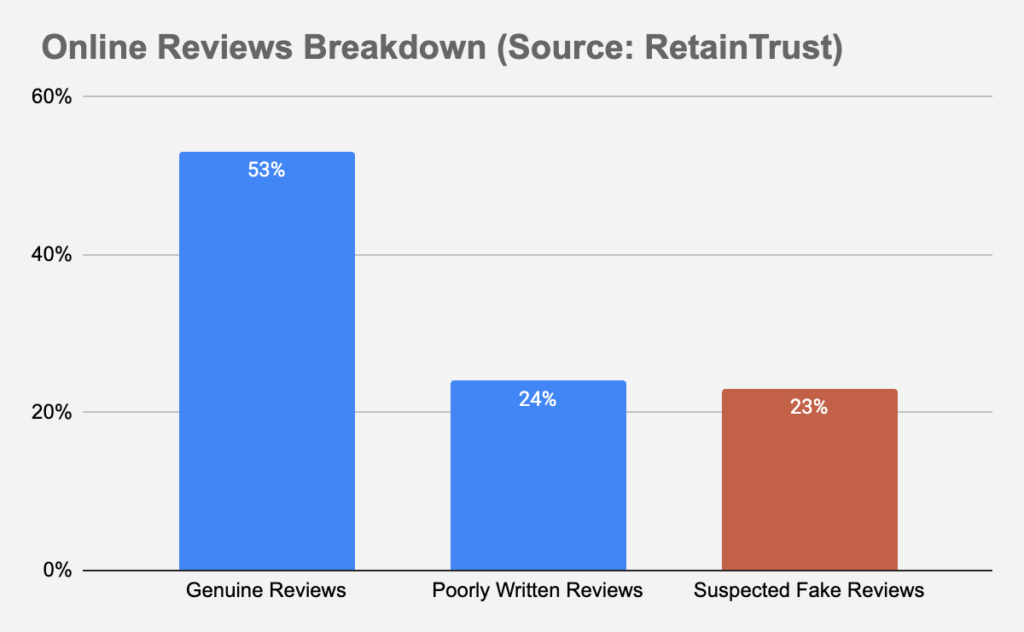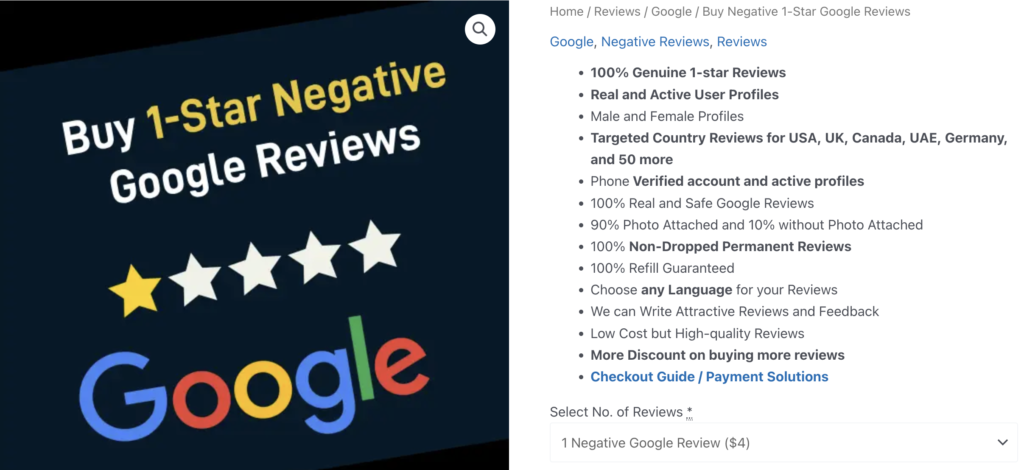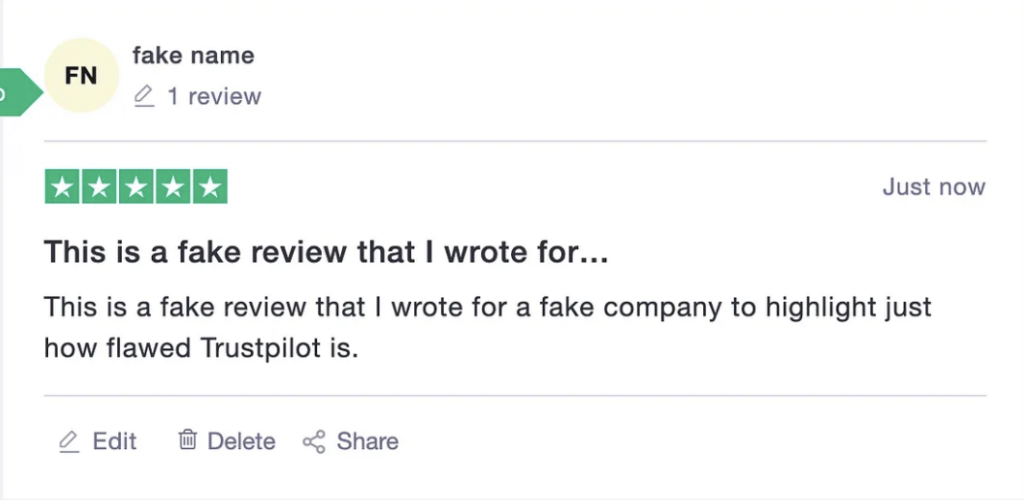Fake reviews come in many forms and shapes, and all unnecessary and disruptive, driving everyone in the organization crazy asking “how can we make it stop?”. Some may come from people you know like a real customer or former employee, but instead of a single negative review, some people take it to the next extreme level by blowing things out of proportion, lying or posting multiple reviews. Then there can be competitor attacks, it’s unfortunate when you get competitor “from hell” and it can be tough to get rid of such attacks. And, of course there are poorly written reviews, often from overseas, followed by calls or emails asking for ransom payment to remove them.
Fake Reviews. The Hidden Threat to Your Business

Don’t be the business that is plagued with bad and fake reviews, with no one taking care of them. Paying attention to your reviews and addressing fake ones immediately is necessary, here is why:
- Customer Perception. Unfortunately, fake reviews can heavily influence potential customers’ perceptions of a business. Not all customers can easily spot fake reviews, and often think of them as legitimate feedback from previous customers. Also, some customers can judge business by the average star rating without reading the actual reviews.
- Traffic, Sales and Revenue. A drop in customer trust because of fake reviews can directly impact foot or online traffic to your business, sales and revenue. Potential customers who are deterred by negative reviews might choose to go to competitors, leading to a significant loss of business.
- Search Engine Rankings (SEO) and Online Presence. Online reviews are a critical component of a business’s search engine optimization (SEO). Negative reviews can lower a business ranking on search engines like Google or Bing, making it harder for potential customers to find your product or service.
- Click-through-rate (CTR) can drop because search engine display the average star rating in the results
- Generative AI Appearance. GenAI search platforms like ChatGPT, Google Gemini, DeepSeek or Bing Copilot can display those reviews and it’ll affect how your business is recommended.
- Brand Image. Consistently negative reviews can tarnish a your brand image, making it difficult to attract new loyal customers and retain existing ones. A damaged reputation can take a long time and cost to rebuild and can result in lasting negative consequences.
Fake reviews lead to increased costs as you might need to invest more money in marketing and reputation management to combat the damage and facilitate positive reviews from real customers. In addition, the presence of fake reviews can complicate your ability to collect honest customer feedback, making it harder to identify genuine areas for improvement.
Fake Reviews Come at High Cost for Businesses
According to the World Economic Forum, online reviews are projected to influence $3.8 trillion in global e-commerce spending. The issue of fake reviews has become so severe that in 2024, the FTC announced plans to work toward banning fake reviews and testimonials.
Example How a Former Employee’s Fake Reviews Can Cost a Company to Rebuild Reputation
One of our clients has been dealing with the same individual posting fake reviews over several years across various platforms like Google Maps, Yelp, and Glassdoor. This person, who had history of erratic behavior and legal troubles, was hired despite warnings from others. Instead of being grateful, he was back to being confrontational, was caught stealing, and finally fired.
While it’s common for a disgruntled former employee to share their side of the story through online review, this individual has held a grudge for years, engaging in fake negative review “bombing” from various fake accounts every few months.
For this business, as with many others, dealing with fake reviews came at high cost. Resources and marketing budget had to be reallocated to cover reputation management fees.
Online Reviews Breakdown: 23% Are Likely Fake
According to RetainTrust research analyzing online reviews across platforms like Google, Yelp, Glassdoor, Trustpilot, and TripAdvisor, approximately 23% of reviews are suspected to be fraudulent.

| Online Reviews Breakdown | % |
| Genuine Reviews | 53 |
| Poorly Written Reviews | 24 |
| Suspected Fake Reviews | 23 |
The prevalence of fraudulent reviews, as highlighted by our research across major platforms such as Google, Yelp, Glassdoor, Trustpilot, and TripAdvisor, points to the challenges businesses face in maintaining the authenticity of online feedback.
The Significance of Online Reviews By the Numbers
Establishing a successful business requires years of dedication and significant investments, but just a few negative and fake reviews can damage your online reputation and impact your sales.
Here’s data illustrating the impact of review networks on customer decision-making:
- More than 88% shoppers trust online reviews as personal recommendations according to Search Engine Land
- Better online reviews can increase your click-though-rates (CTR) by 25%
- For B2B buyers, research shows over 80% clients thoroughly research companies before reaching out.
- When job hunting, almost 60% of candidates would avoid companies with bad reviews. Many would turn down interviews or job offers if a company has too many low ratings from current and former employees on sites like Glassdoor or Indeed.
For example, one of our software clients experienced a 30% increase in their close rate thanks to positive online reviews on platforms like Capterra and G2, as well as traditional business and local networks such as Google My Business and Trustpilot. Many new clients mentioned these favorable reviews as a key factor in choosing their technology over competitors.
Same, our eCommerce client saw over a 25% boost in shopping cart sales and reduced abandonment rates following improved reviews and getting rid of fake ones on shopping networks and review aggregator sites.
And when it comes to job recruitment, a staffing agency client we worked with, observed increase in job applicants when their reviews on Glassdoor and Indeed improved to an average rating of over 4 stars.
Many businesses find managing and replying to online reviews across various networks time consuming. However, the data above shows that in today’s world maintaining a good online reputation and combating fake and unjust reviews should be a top priority for any business.
The Impact of Fake Reviews on GenAI Recommendations
It is well known fact that AI networks like ChatGPT use algorithms to rank and recommend businesses based on online reviews across different sites. GenAI platforms frequently gather company reviews to suggest products and services. Unfortunately, fake reviews can distort the overall perception of a business on these platforms, influencing how it’s recommended and in some cases, fake reviews may even be highlighted in those recommendations. That’s why managing fake reviews is a big part of GenAI optimization.
How Negative Review Scams Work
Scammers frequently use freelance platforms, social media, and dark web markets to offer their services at remarkably low prices. For as little as $4, less than a cup of coffee in the US, they offer to publish fake negative reviews on major platforms such as Google, Yelp, and TripAdvisor. It’s advertised that those fake reviews will appear to look genuine, complicating both businesses and customers ability to distinguish between real and fake feedback, and make it hard to report and take it down.

From the screenshot above, this site was found on Google, in organic results! You might think scammers operate exclusively on the ‘dark web’ and that you need to ‘know a guy who knows a guy’ to reach out to them. But no, they operate openly in web discussions on Medium, Reddit, Quora and rank well on search engines like Google and Bing. In fact, we even received offers via email and social media to purchase fake reviews.
Motivations Behind Fake Negative Reviews and Scams
Negative review scams and fake reviews can come from various motivations, each aimed at undermining a business’s reputation and financial stability.
- Competitor Sabotage. Competitors can write themselves or hire scammers to post fake negative reviews to gain an unfair advantage.
- Extortion. Some scammers post negative reviews and then contact and demand payment from the targeted business to remove them. This form of extortion preys on the business owners desire to protect its reputation. Often they look for businesses that proactively manage their pages, monitor and respond to all reviews.
- Personal Vendettas. Individuals with a personal grudge against a business, business owners, or employees may write or hire scammers to post negative reviews as a form of retaliation. Also, it can be former clients, vendors, disgruntled employees.
It’s always helpful to identify motivations why someone posted fake feedback and present it as evidence when flagging and reporting those reviews.
Types of Platforms Where Scammers Can Post Fake Online Reviews
From our experience, scammers and spammers frequently target popular business with the highest traffic and good reputation. Competitors aiming to harm your reputation often choose high visibility review sites like Google My Business (Google Maps) or Yelp. Additionally, competitors often target niche sites where your offerings are compared directly with theirs. Meanwhile, disgruntled employees or individuals with personal grudges tend to post negative content on professional sites like Glassdoor or on social media.
According to multiple reports, many fake reviews end up on Trustpilot because the platform has yet to address vulnerabilities scammers exploit. Example below shows how easy it is to create fake profile on Trustpilot and post fake review with almost instant approval:

How to Spot Fake Reviews
Identifying and understanding the various forms of fake online reviews can help businesses navigate and combat their impact effectively:
- Poorly Written Reviews. Reviews with grammatical errors, content that doesn’t make sense, or incoherent language may signal fake reviews written in hurry, not putting too much thought, or by individuals not proficient in the language.
- Broad and Too Generic Feedback. Reviews that are overly broad or lack specific details about products, services, or real customer experiences may be indicators of fake reviews. Sometimes those reviews have as little feedback as “bad customer service”, or “this company is scam”, or nothing written at all but 1 star rating. Genuine reviews typically include specific information relevant to the customer real interaction.
- Bot and AI Generated Reviews. Reviews generated by AI automated bots with lack authentic human experiences and often use generic repetitive language. These reviews can appear in large numbers within a short period, with goal to manipulate ratings.
- Non Genuine Reviews. These reviews do not reflect real customer real experiences and may be vague, overly positive or negative without specific details.
- Dishonest Reviews. Reviews containing false information or even lies about a business can severely damage its reputation. These reviews may be motivated by personal vendettas, competition, or extortion.
- Multiple Accounts. Individuals or entities create multiple fake profiles to post reviews, inflating or deflating a business ratings. This tactic aims to deceive potential customers about a business’s reputation and star ratings. Those accounts often new, have no history writing previous reviews, don’t appear to be active in the future.
- Sudden Influx of Reviews. A sudden surge in reviews, especially if they are uniformly positive or negative, can indicate orchestrated efforts to manipulate public opinion and ratings. These reviews often lack consistency or genuine feedback.
Understanding these common types of fake reviews helps businesses to proactively monitor and address fraudulent feedback, safeguarding their online reputation and maintaining trust with customers.
Example of a Fake Review

A typical fake review that came from “PK” (Pakistan), a location where the business doesn’t operate. The review has generic text, grammar mistakes, and irrelevant information, and came from a non-established account. It appeared together with other similar reviews around the same time. To avoid detection, scammer gave 2 stars knowing that 1 star reviews may raise more suspicion of being fake.
Why Review Sites Approve Policy-Violating Fake Reviews
When scammers and “bad actors” submit fake reviews, they exploit the fact that review networks handle thousands of reviews daily, making it easy for moderators and automated systems to miss and accidentally approve fraudulent content. These scammers often use multiple accounts and create new tactics to bypass moderation. Once they identify a vulnerability, they flood the network with more fake reviews until the issue is detected and the review policies are updated. This is why it’s important for business owners to regularly monitor their online presence and flag any problematic and suspected fake reviews.
Combating Fake Negative Reviews and Scams

As online reviews make big impact to influence over consumer decisions, businesses must be vigilant in monitoring and managing their online presence and fight fake reviews:
- Monitoring Reviews. Businesses should regularly monitor their reviews across all platforms to quickly identify and address any suspicious activity.
- Reporting Fraudulent Reviews. Most review platforms have ways for reporting fraudulent and fake reviews. Businesses can take advantage of these tools to flag, challenge and remove questionable reviews.
- Encouraging Genuine Reviews. By encouraging loyal customers to leave positive reviews, businesses can help ensure that genuine feedback outweighs any negativity.
- Legal Action. In some cases, businesses may need to pursue legal advice and action against individuals or entities engaging in defamatory practices.
How to Report & Remove Fake Reviews Online
Flagging and reporting fake reviews involves a systematic approach to ensure they are addressed effectively. Every review network has different ways on how to report questionable reviews. Here’s a general guide to help you report fake reviews across different platforms:
- Identify Fake or Review in Question
- Analyze the Content. Look for common signs of a fake review, such as overly negative language, bad grammar and mistakes, lack of specific details about the product or service, or inconsistencies in the reviewer’s history.
- Check Reviewer Profile. Investigate the reviewer’s profile to see if they have a pattern of leaving similar negative reviews, or if their account seems suspiciously new, or there multiple similar accounts interconnected with each other.
- Gather Evidence
- Document the Review in Question. Take screenshots of the fake review and any additional relevant details that may support your claim. For example communication record, transaction logs, reviews on other platforms written by the same individual.
- Collect Supporting Information. Gather any additional evidence that shows the review is not genuine or fake, such as proof that the reviewer never interacted with your business in the past.
- Report the Review
- Locate How to Report. Find the reporting or flagging tool or link on the review platform. This is typically found next to or below the review, or go to “contact us” or “support” page.
- Research Platform Guidelines. Each platform has its own content rules and guidelines for reporting reviews. Make sure to follow these guidelines closely to ensure your report is considered and increase chances for successful removal.
- Provide Specific Details and Evidence. Clearly and professionally explain why the review is fake and provide any evidence you have. Be very specific and concise in your explanation for moderators to take a second look.
- Submit Your Report
- Complete the Submission. Follow prompts to complete the report submission process. This may include filling out a form or selecting specific reasons or categories for the report.
- Keep Records. Save a copy of your report submission and any correspondence with the platform for future reference, some platforms have appealing processes if they denied your original request. Also, you might have another attempt in the future by providing more evidence that the review is fake.
- Follow Up
- Monitor the Status of Your Report. Keep an eye on the status of your report. Platforms may take time to review and respond to it. Often it can take from 2 to 5 business days to get reply. However, some platforms might never follow up and remove or keep the review.
- Contact Support. If the review is not removed promptly or if you do not receive a response, try contacting the platform support for further help.
Following these steps can significantly increase your chances of successfully removing fake reviews.
Tips for Effectively Reporting Fake Reviews
Here for best practices and tips for effective reporting of fake reviews and increase chances for successful removal:
- Gather Evidence. Collect screenshots, transaction records, or communication logs that support your claim.
- Be Specific. Clearly articulate why the review is fraudulent and detail how it violates the platform rules.
- Follow Up. If the review isn’t removed, reach out to the platform’s support team for additional assistance.
- Persistence Pays. Stay persistent in your efforts to have the fake review addressed, sometimes it takes several attempts to take it down.
- Maintain Professionalism. Approach all communications with the platform’s moderators in professional manner to maximize your chances of a positive outcome.
Keep in mind that review networks are typically monitored by real human moderators who review reports to determine if reviews are real or fake, and whether they violate the platform’s guidelines. By following the steps listed above, you can improve your chances of persuading moderators to support your case.

RetainTrust assists businesses in removing negative and fake reviews. You only pay when the removal is successfully confirmed.
Mistakes to Avoid When Dealing with Fake Reviews
Dealing with fake reviews requires a strategic approach to avoid common mistakes:
- Insufficient Evidence and Emotional Appeals. It’s crucial to gather evidence before reporting a fake review. Emotional appeals or reacting impulsively can weaken your case when moderators review it. It makes it harder to convince review platforms to take action.
- Posting Fake Positive Reviews. Attempting to counteract negative reviews with fake positive ones can backfire. Review platforms have sophisticated algorithms and moderation processes that can detect inauthentic reviews, leading to penalties and loss of credibility. The worst can happen, your fake (and even some genuine ones) positive reviews will be taken down but the fake ones will stay.
- Avoid Replying to Fake Reviews. Engaging with fake reviews through replies is generally discouraged. Responding defensively or sarcastically can accidentally validate the fake review in the eyes of potential customers.
- Also, by replying to fake review, you add weight to it, platform’s algorithms might start showing it on the top as more relevant and featured, and it will be picked up and rank better by search engines as well. Instead, focus on flagging and reporting fake reviews through the platform’s official channels.
- Don’t Retaliate or Escalate. All fake reviews should be promptly flagged and reported using the platform’s designated reporting tools. Avoid the temptation to engage directly with the reviewer or retaliate, as this can escalate the situation.
By navigating these challenges and following best practices, businesses can effectively manage and remove fake reviews while preserving their online credibility and customer trust.
What to Do If You Can’t Remove a Fake Review
If you find that a fake review cannot be removed through the usual reporting channels on the platform, there are several steps you can take. First, try escalating your case within the review platform’s support team. Sometimes, a different department or higher authority can assess the situation and take actions. If this doesn’t work, consider seeking legal advice, especially if the fake review crosses into defamation and violates laws.
Also, investing in online reputation management services can be beneficial. These services specialize in minimizing the impact of negative online content including fake reviews and promoting positive aspects of your business. It’s also important to encourage satisfied and loyal customers to leave their positive reviews, which can help offset the effect of any fake reviews.
Can You Pay or Sponsor a Network to Remove Bad Reviews?
While most review platforms prioritize maintaining integrity by not removing reviews for their sponsors, some networks, unfortunately, may hide, bury, or delete negative reviews for paying customers. It raises ethical concerns and questions, yet there has been no significant legal action taken against platforms that engage in such practices thus far.
Many reputation management companies and advisors can assist with navigating various review platforms. They can advise on which review networks are worth sponsoring and where it is better to maintain a free profile. They also help with flagging and reporting reviews on a regular basis.
Why You Should Never Pay Scammers to Remove Fake Reviews
If you encounter scammers who post fake reviews and demand payment for their removal, avoid responding or paying them. Often they target multiple businesses randomly and wait for response. Engaging with these scammers can have negative consequences:
- Creating a Lead. By responding to their email or call, you become a “goto” contact person for them. This can lead to more harassment and additional fake reviews.
- Escalating the Problem. Paying the scammers might not resolve the issue. Instead, it could encourage them to continue targeting your business or even sell your information to other scammers, leading to more fake reviews and extortion attempts.
The best way to deal is to ignore these scammers. By not engaging they might simply move on and leave you alone, this way you reduce the risk of further attacks and avoid validating their tactics.
Fake Review Reply Examples. How to Respond to Fraudulent Negative Reviews
Engaging with fake reviews through replies is generally discouraged because responding defensively or sarcastically can inadvertently validate the review in the eyes of potential customers. Moreover, responding to a fake review can inadvertently increase its visibility, because platform’s algorithms may see interaction as activity and elevate its prominence. Additionally, search engines might rank it higher due to increased activity and visibility within the platform.
However, if you have exhausted all attempts to flag and remove the review and still feel compelled to respond, it’s important to do so professionally without risking your reputation or causing concern among future customers who might read it.
In your response to a fake review, highlight the fact that there is no record of a transaction, interaction, or service with the person in question. This approach will show other customers that the review likely came from someone who is not a genuine or real customer.
Examples of How to Reply Diplomatically to Fake Reviews
Example #1:
“Thank you for sharing your feedback. We take all customer reviews seriously. Upon reviewing our records, we couldn’t find any transactions or interactions matching your feedback. Please feel free to reach out to our customer service team at [contact information] so we can resolve this matter promptly. Thank you for understanding.”
Example #2:
“We appreciate your feedback, unfortunately we are unable to identify your visit based on the information provided. We are dedicated to providing exceptional service and experiences to all our patrons. Please reach out to us directly at [contact information] so we can work towards a resolution. Thank you for your understanding and for allowing us to address this.”
Example #3:
“Thank you for sharing your thoughts. Ensuring our guests have a positive experience is our priority, and we take feedback seriously. However, after reviewing our records, we couldn’t find any bookings or interactions matching your feedback. Please contact us at [contact information] so we can investigate further and address any issues. We appreciate your understanding and hope to hear from you soon.”
Example #4:
“Thank you for taking the time to provide feedback. We are dedicated to delivering exceptional service to all our customers. Upon thorough review of our records, we are unable to verify your visit or interaction with our establishment. Please connect with our customer support team at [contact information] so we can assist you personally.”
For more examples on managing and responding to negative reviews, check out our other blog post: Responding to Negative Reviews Online.
Why Hiring a Reputation Management Company for Fake Reviews is Smart
Dealing with fake reviews can be challenging and, without experience, things might escalate and worsen your reputation. Managing your business takes a lot of time and effort, and fake reviews can disrupt your work and impact your employees. To effectively remove negative reviews and minimize their damage, you need to understand the rules and communicate properly with review networks.
That’s where a professional reputation management company can help. They can identify, flag, and report fake reviews, and have the expertise to handle different review sites. If necessary, they can also support your legal team to protect your company from defamation and harm.
How RetainTrust Can Help You Handle Fake Reviews
With years of experience, RetainTrust assisted hundreds of clients in removing fake and negative reviews from platforms like Google Maps, Yelp, Trustpilot, Glassdoor, Indeed, and more. Contact us to discover how we can help eliminate fake reviews and protect your business.




